BGP Configuration
About this task
Border Gateway Protocol (BGP) is an inter-ISP routing protocol which establishes routing between ISPs. ISPs use BGP to exchange routing and reachability information between Autonomous Systems (AS) on the Internet. BGP makes routing decisions based on paths, network policies and/or rules configured by network administrators. The primary role of a BGP system is to exchange network reachability information with other BGP peers. This information includes information on AS that the reachability information traverses. This information is sufficient to create a graph of AS connectivity from which routing decisions can be created and rules enforced.
An AS is a set of routers under the same administration that use Interior Gateway Protocol (IGP) and common metrics to define how to route packets within the AS. AS uses inter-AS routing to route packets to other ASs. For an external AS, an AS appears to have a single coherent interior routing plan and presents a consistent picture of the destinations reachable through it.
Routing information exchanged through BGP supports only destination based forwarding (it assumes a router forwards packets based on the destination address carried in the IP header of the packet).
BGP uses TCP as its transport protocol. This eliminates the need to implement explicit update fragmentation, retransmission, acknowledgment, and sequencing. BGP listens on TCP port 179. The error notification mechanism used in BGP assumes that TCP supports a graceful close (all outstanding data is delivered before the connection is closed).
To define BGP configuration:
Procedure
-
Go to Configuration →
Devices.
The Device Configuration screen displays. This screen lists wireless controllers, service platforms and access points within the managed network.
-
Select a device from the list
displayed.
The selected device's configuration screen displays.
-
Expand the Network node and
select BGP.
The BGP General configuration tab displays by default.
 Border Gateway Protocol - General tab
Border Gateway Protocol - General tab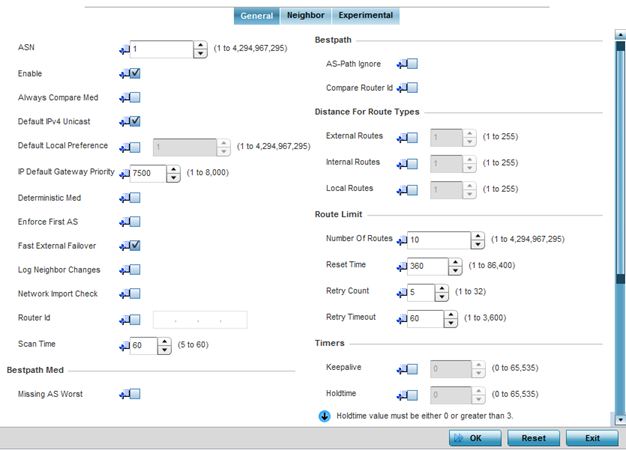
-
Define the following BGP general
configuration parameters:
ASN Define the Autonomous System Number (ASN). ASN is a set of routers under the same administration that use IGP and common metrics to define how to route packets. Select a value from 1 - 4,294,967,295. Enable Enable to start BGP on this controller or service platform. BGP is only supported on NX9500 and NX9600 model controllers and service platforms. The default is disabled. Always Compare MED Multi-exit Discriminator (MED) is a value used by BGP peers to select the best route among multiple routes. When enabled, the MED value encoded in the route is always compared when selecting the best route to the host network. A route with a lower MED value is always selected over a route with a higher MED value. BGP does not discriminate between iBGP and eBGP when using MED for route selection. This option is mutually exclusive to the Deterministic MED option. Default IPv4 Unicast Select this option to enable IPv4 unicast traffic for neighbors. This option is disabled by default. Default Local Preference Select this option to enable a local preference for the neighbor. When enabled, set the local preference value (1 - 4,294,967,295). IP Default Gateway Priority Set the default priority value for the IP Default Gateway. Set a value from 1 - 8000. The default is 7500. Deterministic MED MED is used by BGP peers to select the best route among multiple routes. When enabled, MED route values (from the same AS) are compared to select the best route. This best route is then compared with other routes in the BGP route table to select the best overall route. This option is mutually exclusive to the Always Compare MED option. Enforce First AS Select this option to deny any updates received from an external neighbor that does not have the neighbor‘s configured AS at the beginning of the received AS path parameter. This enhances security by not allowing traffic from an unauthorized AS. This setting is disabled by default. Fast External Failover Select this option to immediately reset the BGP session on the interface once the BGP connection goes down. Normally, when a BGP connection goes down, the device waits for the expiry of the duration specified in Holdtime parameter before bringing down the interface. This setting is enabled by default. Log Neighbor Changes Select this option to enable logging of changes in routes to neighbor BGP peers. This enables the logging of only the changes in neighbor routes. All other events must be explicitly turned on using debug commands. This setting is disabled by default. Network Import Check Select this option to enable a network import check to ensure consistency in advertisements. This setting is disabled by default. Router ID Select this option to manually configure the router ID for this BGP supported controller or service platform. The router ID identifies the device uniquely. When no router ID is specified, the IP address of the interface is considered the router ID. This setting is disabled by default. Scan Time Select this option to set the scanning interval for updating BGP routes. This interval is the period between two consecutive scans the BGP device checks for the validity of routes in its routing table. To disable this setting, set the value to Zero (0). The default setting is 60 seconds. - Optionally, in the Bestpath Med field, select the Missing AS Worst option to treat any path that does not contain a MED value as the least preferable route. This setting is disabled by default.
-
Set the following Bestpath parameters
AS-Path Ignore Select this option to prevent an AS path from being considered as a criteria for selecting a preferred route. The route selection algorithm uses the AS path as one of the criteria when selecting the best route. When this option is enabled, the AS path is ignored. Compare Router ID Select this option to use the router ID as a selection criteria when determining a preferred route. The route selection algorithm uses various criteria when selecting the best route. When this option is enabled, the router ID is used to select the best path between two identical BGP routes. The route with the lower route ID is selected over a route with a higher route id. -
Set or override the following Distance for Route Types.
The distance parameter is a rating of route trustworthiness. The greater the distance, the lower the trust rating. The distance can be set for each type of route indicating its trust rating:
External Routes External routes are those routes learned from a neighbor of this BGP device. Set a value from 1 - 255. Internal Routes Internal routes are those routes learned from another router within the same AS. Set a value from 1 - 255. Local Routes Local routes are those routes being redistributed from other processes within this BGP router. Set a value from 1 - 255. -
Set or override the following Route Limit
parameters:
Number of Routes Configures the number of routes that can be stored on this BGP router. Set this value based on the available memory on this BGP router. Configure a value from 1 - 4,294,967,295. The default value is 9,216 routes. Reset Time Configures the reset time. This is the time limit after which the Retry Count value is set to Zero (0). Set a value from 1- 86,400 seconds. Retry Count Configures the number of time the BGP process is reset before it is shut down. Once shut down, the BGP process has to be started manually. The BGP process is reset if it is flooded with route entries that exceed its number of routes. Set a value from 1 - 32. Retry Timeout Configures the time duration in seconds the BGP process is shutdown temporarily before a reset of the process is attempted. Set a value from 1 - 3,600 seconds. -
Set the following Timers:
Keepalive Set the duration, in seconds, for the keep alive timer used to maintain connections between BGP neighbors. Set a value from 1 - 65,535 seconds. Holdtime Set the time duration, in seconds, for the hold (delay) of packet transmissions. -
Set the following Aggregate Address fields:
Aggregate addresses are used to minimize the size of the routing tables. Aggregation combines the attributes of several different routes and advertises a single route. This creates an aggregation entry in the BGP routing table if more specific BGP routes are available in the specified address range.
IP Prefix Enter an IP address and mask used as the aggregate address. Summary Only Select this option to advertise the IP Prefix route to the BGP neighbor while suppressing the detailed and more specific routes. AS Set Generates AS set path information. Select to enable. When selected, it creates an aggregate entry advertising the path for this route, consisting of all elements contained in all the paths being summarized. Use this parameter to reduce the size of path information by listing the AS number only once, even if it was included in the multiple paths that were aggregated. -
Set the following Distance for IP Source Prefix
fields:
IP Source Prefix Enter an IP address and mask used as the prefix source address Admin Distance Use the spinner control to set the BGP route‘s admin distance from 1 - 255. IP Access List Provide the IP address used to define the prefix list rule. -
Configure the following Network values:
Network Configure an IP address to broadcast to neighboring BGP peers. This network can be a single IP address or a range of IP addresses in A.B.C.D/ M format. Pathlimit Configure the maximum path limit for this AS. Set a value from 1 - 255 AS hops. Backdoor Select this option to indicate to border devices this network is reachable using a backdoor route. A backdoor network is treated the same as a local network, except it is not advertised. This setting is disabled by default. Route Map Select an existing route map as a method of controlling and modifying routing information. The control of route information occurs using route redistribution keys. -
Configure the following Route Redistribute values:
Route Type Use the drop-down menu to define the route type as either connected, kernal, ospf or static. Metric Select this option to set a numeric route metric used for route matching and permit designations. Route Map Select an existing route map as a method of controlling and modifying routing information. The control of route information occurs using route redistribution keys. -
Select the Neighbor tab.
The BGP Neighbor Identifier screen displays. This screen displays a list of configured BGP neighbor devices identified by their IP address.
 Border Gateway Protocol - Neighbor tab
Border Gateway Protocol - Neighbor tab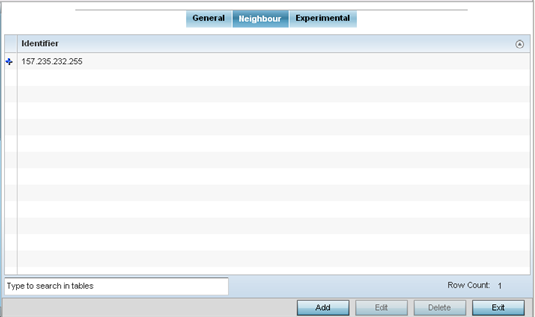
-
Select Add to add a new BGP neighbor configuration or
select an existing Identifier and select Edit to modify
it. The following screen displays with the General tab
selected by default.
 Border Gateway Protocol - Add/Edit - Neighbor - General Tab
Border Gateway Protocol - Add/Edit - Neighbor - General Tab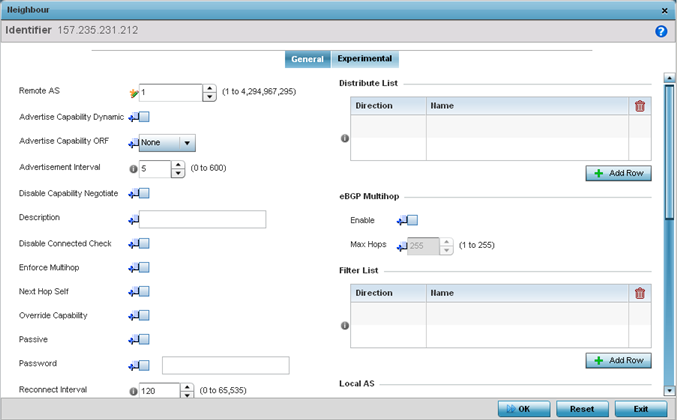
- If adding a new neighbor, in the Identifier field, provide the BGP neighbor's IP address. Click Continue.
-
Configure the following common parameters:
Remote AS Define the ASN for the neighbor BGP device. ASN is a set of routers under the same administration that use IGP and common metrics to define how to route packets within the AS. Set a value from 1 - 4,294,967,295. Advertise Capability Dynamic Select this option to show a neighbor device‘s capability to advertise or withdraw and address capability to other peers in a non-disruptive manner. This setting is disabled by default. Advertise Capability ORF Select this option to enable Outbound Router Filtering (ORF) and advertise this capability to peer devices. ORFs send and receive capabilities to lessen the number of updates exchanged between BGP peers. By filtering updates, ORF minimizes update generation and exchange overhead. The local BGP device advertises ORF in the send mode. The peer BGP device receives the ORF capability in receive mode. The two devices exchange updates to maintain the ORF for each router. Only a peer group or an individual BGP router can be configured to be in receive or send mode. A member of a peer group cannot be configured.
Advertisement Interval Use this option to set the minimum interval between sending BGP router updates. Sending too many router updates creates flapping of routes leading to possible disruptions. Set a minimum interval so that the BGP routing updates are sent after the set interval in seconds. The default is 5 seconds. Disable Capability Negotiate Select to disable capability negotiation with BGP neighbors. This is to allow compatibility with older BGP versions that have no capability parameters used in the open messages between peers. This setting id disabled by default. Description Provide a 80 character maximum description for this BGP neighbor device. Disable Connected Check If utilizing loopback interfaces to connect single-hop BGP peers, enable this option before establishing a the BGP peering session. This setting is disabled by default. Enforce Multihop A multihop route is a route to external peers on indirectly connected networks. Select to enforce neighbors to perform multi-hop check. This setting is disabled by default. Next Hop Self Select to enable Next Hop Self. Use this to configure this device as the next hop for a BGP speaking neighbor or peer group. This allows the BGP device to change the next hop information that is sent to iBGP peers. The next hop address is set to the IP address of the interface used to communicate with the eBGP neighbor. This setting is disabled by default. Override Capability Select this to enable the ability to override capability negotiation result. This setting is disabled by default. Passive Select this option to set this BGP neighbor as passive. When a neighbor is set as passive, the local device should not attempt to open a connection to this device. This setting is disabled by default. Password Select this option, and set a password for this BGP neighbor. This will make all sessions with this neighbor password protected. Reconnect Interval Set a reconnection interval for peer BGP devices from 0 - 65,535 seconds. The default setting is 120 seconds. Send Community Select this option to ensure the community attribute is sent to the BGP neighbor. The community attribute groups destinations in a certain community and applies routing decisions based on the community. On receiving community attribute, the BGP router announces it to the neighbor. Shutdown Select this option to administratively shutdown this BGP neighbor. This setting is disabled by default. Soft Reconfiguration Inbound Select this option to store updates for inbound soft reconfiguration. Soft reconfiguration can be used in lieu of BGP route refresh capability. Selecting this option enables local storage of all received routes and their attributes. This requires additional memory on the BGP device. When a soft reset (inbound) is performed on the neighbor device, the locally stored routes are reprocessed according to the inbound policy. The BGP neighbor connection is not affected.
Update Source Select this option to allow internal BGP sessions to use any operational interface for TCP connections. Use Update Source in conjunction with any specified interface on the router. The loopback interface is the interface that is most commonly used with this command. The use of loopback interface eliminates a dependency and BGP does not have to rely on the availability of a particular interface for making TCP connections. This setting is disabled by default. Unsuppress Map Enable this option to selectively advertise more precise routing information to this neighbor. Use this in conjunction with the Route Aggregate option. The route aggregate command creates a route map with a IP/mask address that consolidates the subnets under it. This enables a reduction in number of route maps on the BGP device to one entry that encompasses all the different subnets. Use Unsuppress Map to selectively allow/deny a subnet or a set of subnets.
Use the Create icon to create a new route map. Use the Edit icon to edit an existing route map list after selecting it.
Weight Select to set the weight of all routes learned from this BGP neighbor. Weight is used to decide the preferred route when the same route is learned from multiple neighbors. The highest weight is always chosen. -
Configure or set the following Default Originate
parameters. Default originate is used by the local BGP router to send
the default route 0.0.0.0 to its neighbor for use as a default route.
Enable Select to enable Default Originate on this BGP neighbor. This setting is disabled by default. Route Map Use the drop-down menu to select a route map (enhanced packet filter) to use as the Default Originate route. -
Configure or set the following Route Map parameters. This
configures how route maps are applied for this BGP neighbor.
Direction Use the drop-down menu to configure the direction on which the selected route map is applied. Select one from in, out, export or import. Route Map Use the drop-down menu to select the route map to use with this BGP neighbor. Use the Create icon to create a new route map. Use the Edit icon to edit an existing route map after selecting it. -
Configure or set the following Distribute List parameters.
Up to 2 distribute list entries can be created.
Direction Use the drop-down menu to configure the direction on which the selected IP access list is applied. Select either in or out. Name Use the drop-down menu to select the route map to use with this BGP neighbor. Use the Create icon to create a new IP Access. -
Configure or set the following eBGP Multihop parameters.
This configures the maximum number of hops that can be between eBGP neighbors
not directly connected to each other.
Enable Select to enable eBGP Multihop on this BGP neighbor. Max Hops Set the maximum number of hops between eBGP neighbors not connected directly. Select a value from 1 - 255. -
Configure or set the following Filter List parameters. Up
to 2 filter list entries can be created.
Direction Use the drop-down menu to configure the direction on which the selected AS Path list is applied. Select either in or out. Name Use the drop-down menu to select the AS Path list to use with this BGP neighbor. Use the Create icon to create a new AS Path list. Use the Edit icon to edit an existing AS Path list after selecting it. -
Configure or set the following Local AS parameters:

Note
This is an experimental feature and its actual operation may be unpredictable.AS Number Specify the local Autonomous System (AS) number. Select from 1 - 4,294,967,295. No Prepend Select to enable. When enabled, the local AS number is not prepended to route updates from eBGP peers. -
Configure or set the following Maximum Prefix value. This
configures the maximum number of prefix that can be received from a BGP
neighbor.
Prefix Limit Sets the maximum number of prefix that can be received from a BGP neighbor. Select from 1 - 4,294,967,295. Once this threshold is reached, the BGP peer connection is reset. Threshold Percent Sets the threshold limit for generating a log message. When this percent of the Prefix Limit is reached, a log entry is generated. For example, if the Prefix Limit is set to 100 and Threshold Percent is set to 65, then after receiving 65 prefixes, a log entry is created. Restart Limit Sets the number of times a reset BGP peer connection is restarted. Select a value from 1 - 65535. Warning Only Select to enable. When the number of prefixes specified in Prefix Limit field is exceeded, the connection is reset. However, when this option is enabled, the connection is not reset and an event is generated instead. This setting is disabled by default. -
Configure or set the following Prefix List parameters. Up
to 2 prefix list entries can be created.
Direction Use the drop-down menu to configure the direction on which the selected IP prefix list is applied. Select either in or out. Name Use the drop-down menu to select the IP prefix list to use with this BGP neighbor. Use the Create icon to create a new IP prefix list or select the Edit icon to edit an existing IP prefix list after selecting it. -
Set or override the following Timers for this BGP
neighbor.
Keepalive Set the time duration in seconds for keepalive. The keep alive timer is used to maintain connections between BGP neighbors. Set a value from 1 - 65,535 seconds. Holdtime Set the time duration in seconds for the hold time. -
Select OK to save the changes and overrides.
Select Reset to revert to the last saved configuration.
-
Select the Experimental tab.

Note
This is an experimental feature and its actual operation may be unpredictable. Border Gateway Protocol - Add/Edit - Neighbor - Experimental Tab
Border Gateway Protocol - Add/Edit - Neighbor - Experimental Tab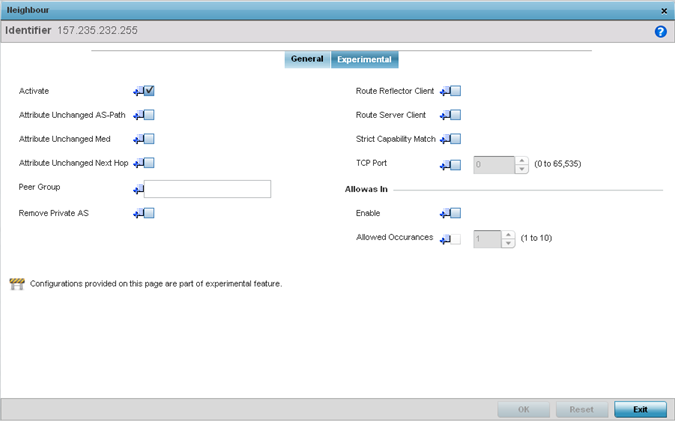
-
Set the following Experimental BGP neighbor
parameters:
Activate Enable an address family for this neighbor. This setting is enabled by default. Attribute Unchanged AS-Path Select to enable propagating AS path BGP attribute unchanged to this neighbor BGP device. This setting is enabled by default. Attribute Unchanged Med Select to enable propagating MED BGP attribute unchanged to this neighbor BGP device. This setting is enabled by default. Attribute Unchanged Next Hop Select to enable propagating the next hop BGP attribute value unchanged to this neighbor BGP device. This setting is enabled by default. Peer Group Set the peer group for this BGP neighbor device. Peer groups are a set of BGP neighbors with the same update policies. This facilitates the updates of various policies, such as, distribute lists and filter lists. The peer group can be configured as a single entity. Any changes made to the peer group is propagated to all members.
Remove Private AS Select this option to remove the private AS number from outbound updates. Private AS numbers are not advertised to the Internet. This option is used with external BGP (eBGP) peers only. The router removes the AS numbers only if the update includes private AS numbers. If the update includes both private and public AS numbers, the system treats it as an error.
Route Reflector Client Select this option to enable this BGP neighbor as a route reflector client for the local router. Route reflectors control large numbers of iBGP peering. Using route reflection, the number of iBGP peers is reduced. This option configures the local BGP device as a route reflector and the neighbor as its route reflector client. This setting is disabled by default. Route Server Client Select this option to enable this neighbor BGP device to act as a route server client. This setting is disabled by default. Strict Capability Match Select this option to enable a strict capability match before allowing a neighbor BGP peer to open a connection. When capabilities do not match, the BGP connection is closed. This setting is disabled by default. TCP Port Select to enable configuration of non-standard BGP port for this BGP neighbor. By default the BGP port number is 179. To configure a non standard port for this BGP neighbor, use the control to set the port number. Select a value from 1 - 65,535. -
Configure or set the following Allowas In
parameters.
This configures the Provider Edge (PE) routers to allow the re-advertisement of all prefixes containing duplicate ASN. This creates a pair of VPN Routing/Forwarding (VRF) instances on each PE router to receive and re-advertise prefixes. The PE router receives prefixes with ASNs from all PE routers and advertises to its neighbor PE routers on one VRF. The other VRF receives prefixes with ASNs from the Customer Edge (CE) routers and re-advertises them to all PE routers in the configuration.
Enable Select this option to enable re-advertisement of all prefixes containing duplicate ASNs. Allowed Occurrences Set the maximum number of times an ASN is advertised. Select a value in the rage 1 - 10. -
Select OK to save the changes and overrides.
Select Reset to revert to the last saved configuration. Select Exit to close this window and go back to the main screen.
-
Select the Experimental tab from the BGP main
screen.

Note
This is an experimental feature and its actual operation may be unpredictable. Border Gateway Protocol - Experimental tab
Border Gateway Protocol - Experimental tab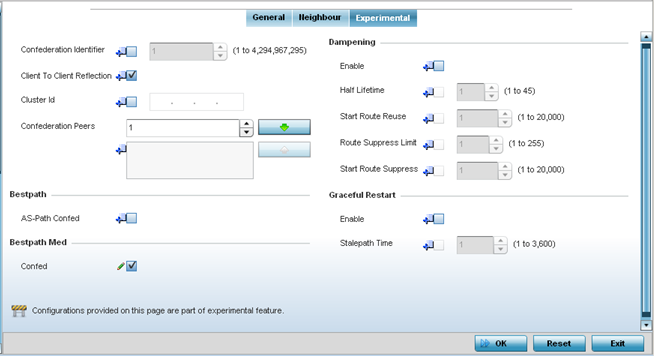
-
Set the following Experimental BGP features:
Confederation Identifier Enable and set a confederation identifier to allow an AS to be divided into several ASs. This confederation is visible to external routers as a single AS. Select a value from 1 - 4,294,967,295. Client to Client Reflection Select to enable client-to-client route reflection. Route reflectors are used when all iBGP speakers are not fully meshed. If the clients are fully meshed, the route-reflectors are not required. The default is enabled. Cluster ID Select to enable and set a Cluster ID if the BGP cluster has more than one route-reflectors. A cluster generally consists of a single router reflector and its clients. The cluster is usually identified by the router ID of this single route-reflector. Sometimes, to increase the redundancy, a cluster might have more than one route-reflectors configured. In this case, all route-reflectors in the cluster are identified by the Cluster ID. Select a value from 1 - 4,294,967,295. Confederation Peers Use this spinner to select the confederation members. Once selected, select the Down Arrow button next to this control to add the AS as a confederation member. Multiple AS configurations can be added to the list of confederation members. To remove an AS as a confederation member, select the AS from the list and select the Up Arrow button next to the list. -
Configure or set the following Bestpath parameter:
AS-Path Confed Select this option to allow the comparison of the confederation AS path length when selecting the best route. This indicates the AS confederation path length must be used, if available, in the BGP path when deciding the best path. -
Configure or set the following Bestpath Med
parameter:
Confed Select to enable. Use this option to allow comparing MED when selecting the best route when learned from confederation peers. This indicates that MED must be used, when available, in the BGP best path when deciding the best path between routes from different confederation peers. -
Configure or set the following Dampening parameters
Dampening minimizes the instability caused by route flapping. A penalty is added for every flap in the flapping route. As soon as the total penalty reaches the Route Suppress Limit value, the advertisement of this route is suppressed. This penalty is delayed when the time specified in Half Lifetime occurs. Once the penalty becomes lower than the value specified in Start Route Reuse, the advertisement of the route is un-suppressed.
Enable Select to enable dampening on advertised routes. When this option is selected, other configuration fields in this Dampening field are enabled. This setting is disabled by default. Half Lifetime Select to enable and configure the half lifetime value. A penalty is imposed on a route that flaps. This is the time for the penalty to decrease to half its current value. Set a value from 1 - 45 in minutes. The default is 1 second. Start Route Reuse Select to enable and configure the route reuse value. When the penalty for a suppressed route decays below the value specified in Start Route Reuse field, the route is un-suppressed. Set a value from 1 - 20000. Route Suppress Limit Select to enable and configure the maximum duration in minutes a suppressed route is suppressed. This is the maximum duration for which a route remains suppressed before it is reused. Set a value from 1 - 255 minutes. Start Route Suppress Select to enable and configure the route suppress value. When a route flaps, a penalty is added to the route. When the penalty reaches or exceeds the value specified in Route Suppress Limit, the route is suppressed. Set a value from 1 - 20000. -
Configure or set the Graceful Restart parameters. This
provides a graceful restart mechanism for a BGP session reset in which the BGP
daemon is not restarted, so that any changes in network configuration that
caused the BGP reset does not affect packet forwarding.
Enable Select to enable a graceful restart on this BGP router. This section is disabled by default. Stalepath Time Configure the maximum time to retain stale paths from restarting neighbor. This is the time the paths from a restarting neighbor is preserved. All stale paths, unless reinstated by the neighbor after reestablishment, are deleted at the expiry of this timer value. Set a value from 1 - 3600 seconds. -
Click OK to save the
changes and overrides.
Click Reset to revert to the last saved configuration. Select Exit to close this window and go back to the main screen.


